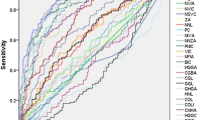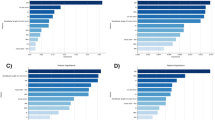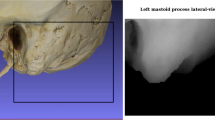Abstract
The aim of the present study is to apply support vector machines (SVM) and artificial neural network (ANN) as sex classifiers and to generate useful classification models for sex estimation based on cranial measurements. Besides, the performance of the generated sub-symbolic machine learning models is compared with models developed through logistic regression (LR). The study was carried out on computed tomography images of 393 Bulgarian adults (169 males and 224 females). The three-dimensional coordinates of 47 landmarks were acquired and used for calculation of the cranial measurements. A total of 64 measurements (linear distances, angles, triangle areas and heights) and 22 indices were calculated. Two datasets were assembled including the linear measurements only and all measurements and index, respectively. An additional third dataset comprising all possible interlandmark distances between the landmarks was constructed. Two machine learning algorithms—SVM and ANN and a traditional statistical analysis LR—were applied to generate models for sex estimation. In addition, two advanced attribute selection techniques (Weka BestFirst and Weka GeneticSearch) were used. The classification accuracy of the models was evaluated by means of 10 × 10-fold cross-validation procedure. All three methods achieved accuracy results higher than 95%. The best accuracy (96.1 ± 0.5%) was obtained by SVM and it was statistically significantly higher than the best results achieved by ANN and LR. SVM and ANN reached higher accuracy by training on the full datasets than the selection datasets, except for the sample described by the interlandmark distances, where the reduction of attributes by the GeneticSearch algorithm improved the accuracy.


Similar content being viewed by others
References
Scheuer L (2002) Application of osteology to forensic medicine. Clin Anat 15:297–312
Dedouit F, Savall F, Mokrane F-Z, Rousseau H, Crubézy E, Rougé D, Telmon N (2014) Virtual anthropology and forensic identification using multidetector CT. Br J Radiol 87:20130468
Iscan MY, Steyn M (2013) The human skeleton in forensic medicine, 3rd edn. Charles C Thomas Publisher, Springfield
Inoue M, Inoue T, Fushimi Y, Okada K (1992) Sex determination by discriminant function analysis of lateral cranial form. Forensic Sci Int 57:109–117. https://doi.org/10.1016/0379-0738(92)90003-f
Hrdlicka A (1939) Practical anthropometry. The Wistar Institute of Anatomy and Biology, Philadelphia
Krogman WM (1962) The human skeleton in forensic medicine. Charles C. Thomas, Springfield
Bass WM (1995) Human osteology: a laboratory and field manual of the human skeleton, 4th edn. Archaeological Society, Missouri
Spradley MK, Jantz RL (2011) Sex estimation in forensic anthropology: skull versus postcranial elements. J Forensic Sci 56:289–296. https://doi.org/10.1111/j.1556-4029.2010.01635.x
Jantz RL, Ousley SD (2020) Sexual dimorphism variation in Fordisc samples. In: Klales AR (ed) Sex estimation of the human skeleton: history, methods, and emerging techniques. Elsevier Academic Press, Cambridge, pp 185–200. https://doi.org/10.1016/B978-0-12-815767-1.00012-2
Jantz R, Mahfouz M, Shirley NR, Abdel Fatah E (2013) Improving sex estimation from crania using 3-dimensional CT scans. U.S. Department of Justice, 1–71
Rösing FW, Graw M, Marre B et al (2007) Recommendations for the forensic diagnosis of sex and age from skeletons. HOMO 58:75–89
Santos F, Guyomarc’h P, Bruzek J (2014) Statistical sex determination from craniometrics: comparison of linear discriminant analysis, logistic regression, and support vector machines. Forensic Sci Int 245:204.e1–204.e8. https://doi.org/10.1016/j.forsciint.2014.10.010
McQueen RJ, Holmes G, Hunt L (1998) User satisfaction with machine learning as a data analysis method in agricultural research. N Z J Agric Res 41:577–584
Valdes G, Chan MF, Lim SB, Scheuermann R, Deasy JO, Solberg TD (2017) IMRT QA using machine learning: a multi-institutional validation. J Appl Clin Med Phys 18:279–284
Magoulas GD, Prentza A (2001) Machine learning in medical applications. In: Paliouras G, Karkaletsis V, Spyropoulos CD (eds) Machine learning and its applications, ACAI 1999, lecture notes in computer science, 2049. Springer, Berlin, Heidelberg, pp 300–307. https://doi.org/10.1007/3-540-44673-7_19
Kording KP, Benjamin A, Farhoodi R, Glaser JI (2018) The roles of machine learning in biomedical science. In: Frontiers of engineering: reports on leading-edge engineering from the 2017 symposium. National Academies Press, Washington, pp 61–72
Toneva D, Nikolova S, Agre G, Zlatareva D, Hadjidekov V, Lazarov N (2020) Data mining for sex estimation based on cranial measurements. Forensic Sci Int 315:110441. https://doi.org/10.1016/j.forsciint.2020.110441
Musilová B, Dupej J, Velemínská J, Chaumoitre K, Bruzek J (2016) Exocranial surfaces for sex assessment of the human cranium. Forensic Sci Int 269:70–77
Čechová M, Dupej J, Brůžek J, Bejdová Š, Horák M, Velemínská J (2019) Sex estimation using external morphology of the frontal bone and frontal sinuses in a contemporary Czech population. Int J Legal Med 133:1285–1294. https://doi.org/10.1007/s00414-019-02063-8
Yang W, Zhou M, Zhang P, Geng G, Liu X, Zhang H (2020) Skull sex estimation based on wavelet transform and Fourier transform. Biomed Res Int 2020:8608209–8608210. https://doi.org/10.1155/2020/8608209
Arigbabu OA, Liao IY, Abdullah N, Noor MHM (2018) Novel group variable selection for salient skull region selection and sex determination. In: Ren J, Hussain A, Zheng J, Liu C-L, Luo B, Zhao H, Zhao X (eds) Advances in brain inspired cognitive systems: BICS 2018. Springer International Publishing, Cham, pp 248–259. https://doi.org/10.1007/978-3-030-00563-4_24
Du Jardin P, Ponsaillé J, Alunni-Perret V, Quatrehomme G (2009) A comparison between neural network and other metric methods to determine sex from the upper femur in a modern French population. Forensic Sci Int 192:127.e1–127.e6. https://doi.org/10.1016/j.forsciint.2009.07.014
Mahfouz M, Badawi A, Merkl B, Abdel Fatah EE, Pritchard E, Kesler K, Moore M, Jantz R, Jantz L (2007) Patella sex determination by 3D statistical shape models and nonlinear classifiers. Forensic Sci Int 173:161–170. https://doi.org/10.1016/j.forsciint.2007.02.024
Navega D, Vicente R, Vieira DN, Ross AH, Cunha E (2014) Sex estimation from the tarsal bones in a Portuguese sample: a machine learning approach. Int J Legal Med 129:651–659. https://doi.org/10.1007/s00414-014-1070-5
Yang W, Liu X, Wang K, Hu J, Geng G, Feng J (2019) Sex determination of three-dimensional skull based on improved backpropagation neural network. Comput Math Methods Med 2019:9163547–9163548. https://doi.org/10.1155/2019/9163547
Bewes J, Low A, Morphett A, Pate F, Henneberg M (2019) Artificial intelligence for sex determination of skeletal remains: application of a deep learning artificial neural network to human skulls. J Forensic Legal Med 62:40–43. https://doi.org/10.1016/j.jflm.2019.01.004
Cignoni P, Callieri M, Corsini M, Dellepiane M, Ganovelli F, Ranzuglia G (2008) MeshLab: an open-source mesh processing tool. In: Scarano V, de Chiara R, Erra U (eds) Sixth eurographics Italian chapter conference. Eurographics Association, Salerno, pp 129–136
Hammer Ø, Harper DAT, Ryan PD (2001) PAST: paleontological statistics software package for education and data analysis. Palaeontol Electron 4:9–18
Franklin D, Cardini A, Flavel A, Kuliukas A (2013) Estimation of sex from cranial measurements in a Western Australian population. Forensic Sci Int 229:158e1–158e8. https://doi.org/10.1016/j.forsciint.2013.03.00
Cortes C, Vapnik V (1995) Support-vector networks. Mach Learn 20:273–297
Demšar J, Curk T, Erjavec A, Gorup Č, Hočevar T, Milutinovič M, Možina M, Polajnar M, Toplak M, Starič A, Stajdohar M, Umek L, Žagar L, Žbontar J, Žitnik M, Zupan B (2013) Orange: data mining toolbox in Python. JMLR. 14:2349–2353
Witten IH, Frank E, Hall MA, Pal CJ (2017) Data mining: practical machine learning tools and techniques (Morgan Kaufmann series in data management systems), 4th edn. Morgan Kaufmann Publishers, San Francisco
Mitchell T (1997) Machine learning. McGraw-Hill Science/Engineering/Math, New York
Witten IH, Frank E, Hall MA (2011) Data mining: practical machine learning tools and techniques. Morgan Kaufmann Publ, Burlington
Hall MA (1998) Correlation-based feature subset selection for machine learning, PhD Thesis, University of Waikato, Hamilton
Molinaro AM, Simon R, Pfeiffer RM (2005) Prediction error estimation: a comparison of resampling methods. Bioinformatics 21:3301–3307. https://doi.org/10.1093/bioinformatics/bti499
Kim J-H (2009) Estimating classification error rate: repeated cross-validation, repeated hold-out and bootstrap. Comput Stat Data Anal 53:3735–3745
Han J, Kamber M, Pei J (2012) Data mining concepts and techniques, 3rd edn. Morgan Kaufmann Publishers, Waltham
Klales AR, Ousley SD, Passalacqua NV (2020) Statistical approaches to sex estimation. In: Klales AR (ed) Sex estimation of the human skeleton: history, methods, and emerging techniques. Elsevier Academic Press, Cambridge, pp 203–217. https://doi.org/10.1016/B978-0-12-815767-1.00013-4
Abdel Fatah EE, Shirley NR, Jantz RL, Mahfouz MR (2014) Improving sex estimation from crania using a novel three-dimensional quantitative method. J Forensic Sci 59:590–600. https://doi.org/10.1111/1556-4029.12379
Giles E, Elliot O (1963) Sex determination by discriminant function analysis of crania. Am J Phys Anthropol 21:53–68
Steyn M, Iscan MY (1998) Sexual dimorphism in the crania and mandibles of south African whites. Forensic Sci Int 98:9–16. https://doi.org/10.1016/s0379-0738(98)00120-0
Dayal MR, Spocter MA, Bidmos MA (2008) An assessment of sex using the skull of black south Africans by discriminant function analysis. HOMO 59:209–221. https://doi.org/10.1016/j.jchb.2007.01.001
Ogawa Y, Imaizumi K, Miyasaka S, Yoshino M (2013) Discriminant functions for sex estimation of modern Japanese skulls. J Forensic Legal Med 20:234–238. https://doi.org/10.1016/j.jflm.2012.09.023
Ekizoglu O, Hocaoglu E, Inci E, Can IO, Solmaz D, Aksoy S, Buran CF, Sayin I (2016) Assessment of sex in a modern Turkish population using cranial anthropometric parameters. Legal Med 21:45–52. https://doi.org/10.1016/j.legalmed.2016.06.001
Zaafrane M, Ben KM, Naccache I, Ezzedine E, Savall F, Telmon N, Mnif N, Hamdoun M (2017) Sex determination of a Tunisian population by CT scan analysis of the skull. Int J Legal Med 132:853–862. https://doi.org/10.1007/s00414-017-1688-1
Franklin D, Cardini A, Flavel A, Kuliukas A (2012) The application of traditional and geometric morphometric analyses for forensic quantification of sexual dimorphism: preliminary investigations in a Western Australian population. Int J Legal Med 26:549–558
Dillon A (2014) Cranial sexual dimorphism and the population specificity of anthropological standards. Master Thesis, University of Western Australia
Marinescu M, Panaitescu V, Rosu M, Maru N, Punga (2014) A sexual dimorphism of crania in a Romanian population: discriminant function analysis approach for sex estimation. Rom J Leg Med 22:21–26. https://doi.org/10.4323/rjlm.2014.21
Ibrahim A, Alias A, Nor FM, Swarhib M, Bakar AN, Das S (2017) Study of sexual dimorphism of Malaysian crania: an important step in identification of the skeletal remains. Anat Cell Biol 50:86–92. https://doi.org/10.5115/acb.2017.50.2.86
Toneva D, Nikolova S, Zlatareva D, Hadjidekov V, Lazarov N (2019) Sex estimation by mastoid triangle using 3D models. HOMO 70:63–73. https://doi.org/10.1127/homo/2019/1010
Gao H, Geng G, Yang W (2018) Sex determination of 3D skull based on a novel unsupervised learning method. Comput Math Methods Med 2018:4567267. https://doi.org/10.1155/2018/456726
Yang W, Reziwanguli X, Xu J, Wang P, Hu J, Liu X (2018) Sex determination of skull based on fuzzy decision tree. In: Proceedings of the 4th Workshop on Advanced Research and Technology in Industry (WARTIA 2018), Advances in Engineering Research, vol 173, pp 14–20. https://doi.org/10.2991/wartia-18.2018.4
Nikolova S, Toneva D, Agre G, Lazarov N (2020) Data mining for peculiarities in the configuration of neurocranium when the metopic suture persists. Anthropol Anz 77:89–107. https://doi.org/10.1127/anthranz/2019/1051
Kranioti EF, İşcan MY, Michalodimitrakis M (2008) Craniometric analysis of the modern Cretan population. Forensic Sci Int 180:110.e1–110.e5. https://doi.org/10.1016/j.forsciint.2008.06.018
Kimmerle EH, Ross A, Slice DE (2008) Sexual dimorphism in America: geometric morphometric analysis of the craniofacial region. J Forensic Sci 53:54–57
Green H, Curnoe D (2009) Sexual dimorphism in southeast Asian crania: a geometric morphometric approach. HOMO 60:517–534. https://doi.org/10.1016/j.jchb.2009.09.001
Bigoni L, Velemínská J, Brůžek J (2010) Three-dimensional geometric morphometric analysis of cranio-facial sexual dimorphism in a Central European sample of known sex. HOMO 61:16–32. https://doi.org/10.1016/j.jchb.2009.09.004
Bejdová Š, Dupej J, Krajíček V, Velemínská J, Velemínský P (2018) Stability of upper face sexual dimorphism in central European populations (Czech Republic) during the modern age. Int J Legal Med 132:321–330. https://doi.org/10.1007/s00414-017-1625-3
Chovalopoulou ME, Bertsatos A (2018) Exploring the shape variation of the human cranium. A geometric morphometrics study on a modern Greek population sample. In: Rissech C, Lloveras L, Nadal J, Fullola JM (eds) Geometric morphometrics. Trends in biology, paleobiology and archaeology. SERP-UB, Barcelona, pp 25–39
Gonzalez PN, Bernal V, Perez SI (2009) Analysis of sexual dimorphism of craniofacial traits using geometric morphometric techniques. Int J Osteoarchaeol 21:82–91. https://doi.org/10.1002/oa.1109
Franklin D, Freedman L, Milne N (2005) Sexual dimorphism and discriminant function sexing in indigenous South African crania. HOMO 55:213–228. https://doi.org/10.1016/j.jchb.2004.08.001
Saini V, Srivastava R, Rai RK, Shamal SN, Singh TB, Tripathi SK (2011) An osteometric study of northern Indian populations for sexual dimorphism in craniofacial region. J Forensic Sci 56:700–705. https://doi.org/10.1111/j.1556-4029.2011.01707.x
Chovalopoulou ME, Bertsatos A, Manolis SK (2017) Landmark based sex discrimination on the crania of archaeological Greek populations. A comparative study based on the cranial sexual dimorphism of a modern Greek population. Mediter Archaeol Archaeom 17:37–46
Verhoff MA, Ramsthaler F, Krähahn J, Deml U, Gille RJ, Grabherr S, Thali M, Kreutz K (2008) Digital forensic osteology—possibilities in cooperation with the Virtopsy® project. Forensic Sci Int 174:152–156. https://doi.org/10.1016/j.forsciint.2007.03.017
Franklin D, Cardini A, Flavel A, Kuliukas A, Marks MK, Hart R, O’Higgins P (2013) Concordance of traditional osteometric and volume-rendered MSCT interlandmark cranial measurements. Int J Legal Med 27:505–520. https://doi.org/10.1007/s00414-012-0772-9
Stull KE, Tise ML, Ali Z, Fowler DR (2014) Accuracy and reliability of measurements obtained from computed tomography 3D volume rendered images. Forensic Sci Int 238:133–140. https://doi.org/10.1016/j.forsciint.2014.03.005
Toneva D, Nikolova S, Georgiev I (2017) Accuracy of linear measurements on polygonal models of dry mandibles generated from industrial CT data. Acta Morphol Anthropol 24:55–62
Park HK, Chung JW, Kho HS (2006) Use of hand-held laser scanning in the assessment of craniometry. Forensic Sci Int 160:200–206
Richard AH, Parks CL, Monson KL (2014) Accuracy of standard craniometric measurements using multiple data formats. Forensic Sci Int 242:177–185
Toneva D, Nikolova S, Georgiev I (2016) Reliability and accuracy of angular measurements on laser scanning created 3D models of dry skulls. J Anthropol 2016:6218659
Toneva D, Nikolova S, Georgiev I, Tchorbadjieff A (2017) Accuracy of linear craniometric measurements obtained from laser scanning created 3D models of dry skulls. In: Georgiev K, Todorov M, Georgiev I (eds) Advanced computing in industrial mathematics, vol 681. Springer, Cham, pp 215–229
Bertsatos A, Chovalopoulou M-E, Brůžek J, Bejdová Š (2020) Advanced procedures for skull sex estimation using sexually dimorphic morphometric features. Int J Legal Med 134:1927–1937. https://doi.org/10.1007/s00414-020-02334-9
Keen J (1950) A study of differences between male and female skulls. Am J Phys Anthropol 8:65–80
Sierp I, Henneberg M (2015) The difficulty of sexing skeletons from unknown populations. J Anthropol 2015:908535–908513. https://doi.org/10.1155/2015/908535
Kotěrová A, Velemínská J, Dupej J, Brzobohatá H, Pilný A, Brůžek (2017) Disregarding population specificity: its influence on the sex assessment methods from the tibia. Int J Legal Med 131:251–261. https://doi.org/10.1007/s00414-016-1413-5
Isçan MY, Yoshino M, Kato S (1995) Sexual dimorphism in modem Japanese crania. Am J Hum Biol 7:459–464
Langley NR, Jantz RL (2020) Secular change. In: Klales AR (ed) Sex estimation of the human skeleton: history, methods, and emerging techniques. Elsevier Academic Press, Cambridge, pp 295–306. https://doi.org/10.1016/B978-0-12-815767-1.00018-3
Acknowledgments
This work was supported by the Bulgarian National Science Fund [Grant numbers DN01/15-20.12.2016 and DN11/9-15.12.2017].
Funding
This study was funded by the Bulgarian National Science Fund (Grant numbers DN01/15-20.12.2016 and DN11/9-15.12.2017).
Author information
Authors and Affiliations
Contributions
Diana H. Toneva: Conceptualization, methodology, formal analysis, investigation, validation, data curation, visualization, writing—original draft, project administration, and funding acquisition
Silviya Y. Nikolova: Conceptualization, methodology, investigation, validation, writing—review and editing, project administration, and funding acquisition
Gennady P. Agre: Formal analysis, methodology, data curation, writing—review and editing
Dora K. Zlatareva: Resources, writing—review and editing
Vassil G. Hadjidekov: Resources, writing—review and editing
Nikolai E. Lazarov: Writing—review and editing
Corresponding author
Ethics declarations
Conflict of interest
The authors declare that they have no conflict of interest.
Ethics approval
This study was performed in line with the principles of the Declaration of Helsinki. Approval was granted by the Human Research Ethics Committee at the Institute of Experimental Morphology, Pathology and Anthropology with Museum, Bulgarian Academy of Sciences.
Additional information
Publisher’s note
Springer Nature remains neutral with regard to jurisdictional claims in published maps and institutional affiliations.
Rights and permissions
About this article
Cite this article
Toneva, D., Nikolova, S., Agre, G. et al. Machine learning approaches for sex estimation using cranial measurements. Int J Legal Med 135, 951–966 (2021). https://doi.org/10.1007/s00414-020-02460-4
Received:
Accepted:
Published:
Issue Date:
DOI: https://doi.org/10.1007/s00414-020-02460-4




